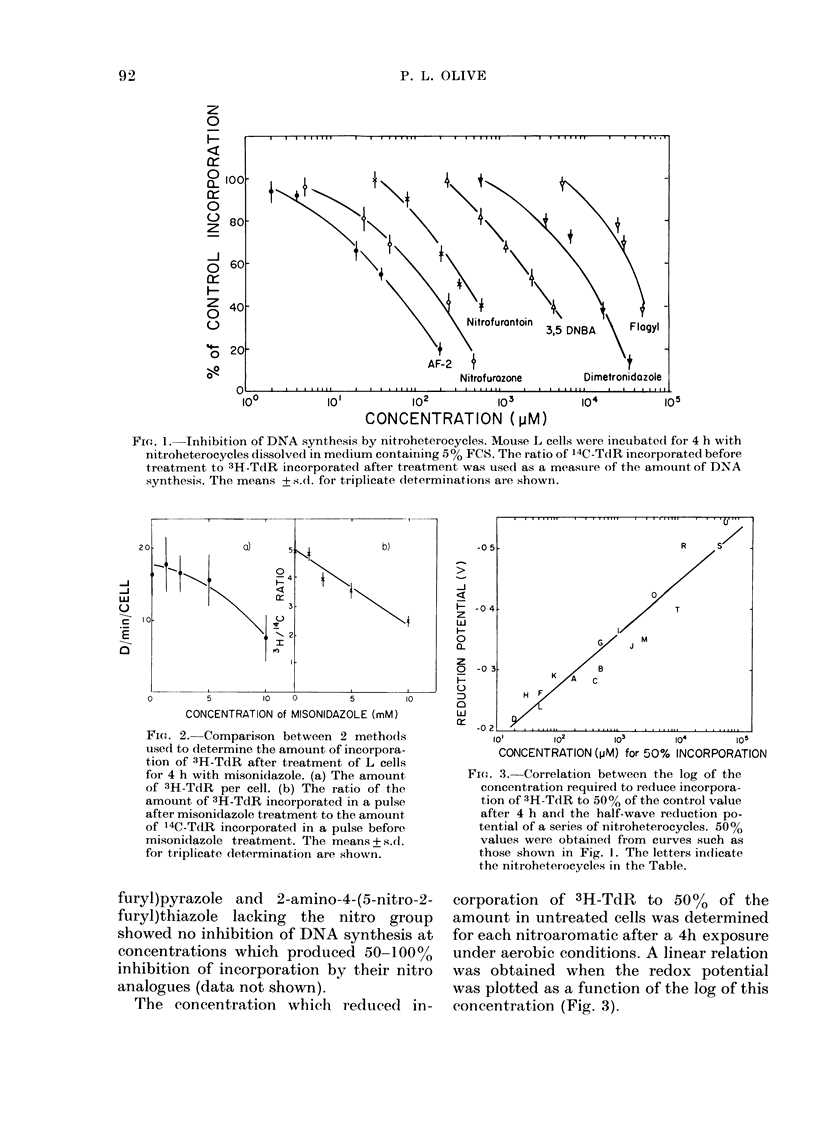Abstract
Twenty-one nitroheterocycles, including metronidazole, misonidazole and AF-2, were tested for their ability to inhibit DNA synthesis in mouse L-929 cells growing in culture. All those tested inhibited the rate of incorporation of 3H-thymidine into L cells following drug treatment for 4 h under aerobic conditions. Only 4 drugs reached their limits of solubility before the uptake of 3H-thymidine was inhibited by 50% or more. For the remaining 17, the log of the concentration producing 50% inhibition of incorporation was directly correlated with the half-wave reduction potential of the compound.
Full text
PDF




Selected References
These references are in PubMed. This may not be the complete list of references from this article.
- Chapman J. D., Reuvers A. P., Borsa J. Effectiveness of nitrofuran derivatives in sensitizing hypoxic mammalian cells to x rays. Br J Radiol. 1973 Aug;46(548):623–630. doi: 10.1259/0007-1285-46-548-623. [DOI] [PubMed] [Google Scholar]
- Hirano K., Yoshina S., Okamura K., Suzuka I. Electronic aspect of the antibacterial activity of nitrofuran derivatives. Bull Chem Soc Jpn. 1967 Oct;40(10):2229–2233. doi: 10.1246/bcsj.40.2229. [DOI] [PubMed] [Google Scholar]
- Loeb L. A., Springgate C. F., Battula N. Errors in DNA replication as a basis of malignant changes. Cancer Res. 1974 Sep;34(9):2311–2321. [PubMed] [Google Scholar]
- Lu C., McCalla D. R. Action of some nitrofuran derivatives on glucose metabolism, ATP levels, and macromolecule synthesis in Escherichia coli. Can J Microbiol. 1978 Jun;24(6):650–657. doi: 10.1139/m78-109. [DOI] [PubMed] [Google Scholar]
- Mason R. P., Holtzman J. L. The mechanism of microsomal and mitochondrial nitroreductase. Electron spin resonance evidence for nitroaromatic free radical intermediates. Biochemistry. 1975 Apr 22;14(8):1626–1632. doi: 10.1021/bi00679a013. [DOI] [PubMed] [Google Scholar]
- McCalla D. R., Reuvers A., Kaiser C. Mode of action of nitrofurazone. J Bacteriol. 1970 Dec;104(3):1126–1134. doi: 10.1128/jb.104.3.1126-1134.1970. [DOI] [PMC free article] [PubMed] [Google Scholar]
- Olive P. L., Durand R. E. Activation of radiosensitizers by hypoxic cells. Br J Cancer Suppl. 1978 Jun;3:124–128. [PMC free article] [PubMed] [Google Scholar]
- Olive P. L. Inhibition of DNA synthesis by nitroheterocycles. II. Mechanisms of cytotoxicity. Br J Cancer. 1979 Jul;40(1):94–104. doi: 10.1038/bjc.1979.145. [DOI] [PMC free article] [PubMed] [Google Scholar]
- SASAKI T. Polarographic study of nitrofuran derivatives. II. Reduction potential of nitrofuran derivatives and nitrobenzene analogs. Pharm Bull. 1954 Jun;2(2):104–108. doi: 10.1248/cpb1953.2.104. [DOI] [PubMed] [Google Scholar]
- Sealy R. C., Swartz H. M., Olive P. L. Electron spin resonance-spin trapping. Detection of superoxide formation during aerobic microsomal reduction of nitro-compounds. Biochem Biophys Res Commun. 1978 May 30;82(2):680–684. doi: 10.1016/0006-291x(78)90928-2. [DOI] [PubMed] [Google Scholar]
- Wardman P., Clarke E. D. Oxygen inhibition of nitroreductase: electron transfer from nitro radical-anions to oxygen. Biochem Biophys Res Commun. 1976 Apr 19;69(4):942–949. doi: 10.1016/0006-291x(76)90464-2. [DOI] [PubMed] [Google Scholar]


